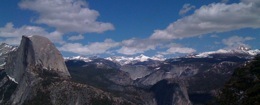The iconic Yosemite National Park (YNP) is among the oldest and most heavily visited protected areas in the world. Encompassing over 3,000 km2—from the foothills of California’s Sierra Nevada Mountains to their 4,000 m crest—YNP hosts ca. 4 million visitors annually, yet much of the park is designated wilderness with only limited trail access. Within its boundaries, YNP harbors a range of natural resources that include: the striking geology of Yosemite Valley; multiple groves of the world’s largest tree, the giant Sequoia; endemic and endangered species; extensive alpine ecosystems; thousands of lakes; and the headwaters of river systems that supply drinking water and farmwater to California’s millions of citizens and multibillion dollar agricultural industry. However, YNP is located upstream and downwind from the Central Valley of California, an intensive agricultural area that suffers extremely poor air quality and presents a stark contrast—with feedlots, factories, and freeways located ~100 km from the Sierra. As a consequence, the National Park Service is concerned about transport of atmospheric pollutants into YNP and their effects (http://www.nps.gov/yose/naturescience/airquality.htm), while climate change has already demonstrably altered small-mammal communities in YNP (Moritz et al. 2008) and is projected to strongly warm the High Sierra in coming decades.
Our research is focused on the microbial ecology of high mountain lakes, which are naturally beautiful and a highlight of Yosemite, but are nutrient-poor (oligotrophic) and may be sensitive to atmospheric pollution. Lakes are also climate sentinels that will be rapidly and substantially altered by anthropogenic climate change (Williamson et al. 2009 and references therein). Among the predicted effects of warming is disruption of lake carbon balance, including elevated microbial respiration rates in sediments (Gudasz et al. 2010) and the water column (Kosten et al. 2010)—changes that are globally significant because lakes and other inland waters play a disproportionate role in the carbon cycle (Cole et al. 2007). At the same time, increasing deposition of atmospheric pollutants (Holtgrieve et al. 2011) has prompted reexamination of nutrient limitation of lake microbial processes and communities (Elser et al. 2009). Yet these changes take place against a backdrop of limited knowledge regarding lake microbial community ecology and biogeochemistry: ‘typical’ freshwater bacteria and their phenology were identified within only the past decade (Zwart et al. 2002, Shade et al. 2007), and relationships between community composition and activity (Comte and del Giorgio 2010 and references therein), and responses to nutrient additions (Newton and McMahon 2011 and references therein), are varied.
We are examining microbial community ecology and biogeochemistry across environmental gradients in YNP mountain lakes, and are using natural gradients in conjunction with experimental manipulation to quantify environmental controls on microbial community composition, diversity, and activity. Our particular foci are the processes of respiration and nitrification.
Mike is also a co-PI for the Yosemite REU program recently funded by NSF. Contact him if you are undergraduate interested in summer research in the Park.
REU program and press release:
https://snri.ucmerced.edu/Yosemite_REU
http://www.ucmerced.edu/news/summer-research-program-undergrads-aims-experience-lifetime
Yosemite info:
Current conditions (weather, webcams, etc.): http://www.nps.gov/yose/planyourvisit/conditions.htm
Wilderness conditions: http://www.nps.gov/yose/planyourvisit/wildcond.htm
Yosemite daily brief: http://www.nps.gov/yose/parknews/upload/daily.pdf
Air quality data and webcam: http://www.nature.nps.gov/air/webcams/parks/yosecam/yosecam.cfm
Yosemite HD: http://vimeo.com/35396305
Photos:
Top left: Half Dome and High Sierra from Glacier Point, May 2011; photo by Mike Beman
Lower left: High Sierra from Glacier Point, September 2009; photo by Mike Beman
Right: Evelyn Lake; photo by Sang Park
The views expressed on this page do not necessarily reflect those of the US National Science Foundation



